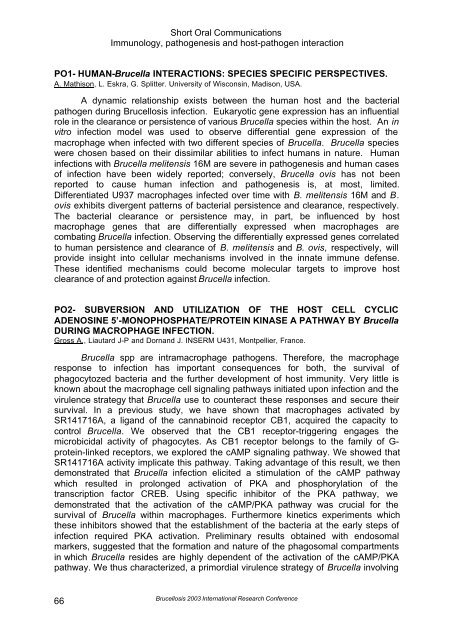Brucellosis 2003 proceedings - PHIDIAS
Brucellosis 2003 proceedings - PHIDIAS
Brucellosis 2003 proceedings - PHIDIAS
You also want an ePaper? Increase the reach of your titles
YUMPU automatically turns print PDFs into web optimized ePapers that Google loves.
Short Oral Communications<br />
Immunology, pathogenesis and host-pathogen interaction<br />
PO1- HUMAN-Brucella INTERACTIONS: SPECIES SPECIFIC PERSPECTIVES.<br />
A. Mathison, L. Eskra, G. Splitter. University of Wisconsin, Madison, USA.<br />
A dynamic relationship exists between the human host and the bacterial<br />
pathogen during <strong>Brucellosis</strong> infection. Eukaryotic gene expression has an influential<br />
role in the clearance or persistence of various Brucella species within the host. An in<br />
vitro infection model was used to observe differential gene expression of the<br />
macrophage when infected with two different species of Brucella. Brucella species<br />
were chosen based on their dissimilar abilities to infect humans in nature. Human<br />
infections with Brucella melitensis 16M are severe in pathogenesis and human cases<br />
of infection have been widely reported; conversely, Brucella ovis has not been<br />
reported to cause human infection and pathogenesis is, at most, limited.<br />
Differentiated U937 macrophages infected over time with B. melitensis 16M and B.<br />
ovis exhibits divergent patterns of bacterial persistence and clearance, respectively.<br />
The bacterial clearance or persistence may, in part, be influenced by host<br />
macrophage genes that are differentially expressed when macrophages are<br />
combating Brucella infection. Observing the differentially expressed genes correlated<br />
to human persistence and clearance of B. melitensis and B. ovis, respectively, will<br />
provide insight into cellular mechanisms involved in the innate immune defense.<br />
These identified mechanisms could become molecular targets to improve host<br />
clearance of and protection against Brucella infection.<br />
PO2- SUBVERSION AND UTILIZATION OF THE HOST CELL CYCLIC<br />
ADENOSINE 5’-MONOPHOSPHATE/PROTEIN KINASE A PATHWAY BY Brucella<br />
DURING MACROPHAGE INFECTION.<br />
Gross A., Liautard J-P and Dornand J. INSERM U431, Montpellier, France.<br />
Brucella spp are intramacrophage pathogens. Therefore, the macrophage<br />
response to infection has important consequences for both, the survival of<br />
phagocytozed bacteria and the further development of host immunity. Very little is<br />
known about the macrophage cell signaling pathways initiated upon infection and the<br />
virulence strategy that Brucella use to counteract these responses and secure their<br />
survival. In a previous study, we have shown that macrophages activated by<br />
SR141716A, a ligand of the cannabinoid receptor CB1, acquired the capacity to<br />
control Brucella. We observed that the CB1 receptor-triggering engages the<br />
microbicidal activity of phagocytes. As CB1 receptor belongs to the family of G-<br />
protein-linked receptors, we explored the cAMP signaling pathway. We showed that<br />
SR141716A activity implicate this pathway. Taking advantage of this result, we then<br />
demonstrated that Brucella infection elicited a stimulation of the cAMP pathway<br />
which resulted in prolonged activation of PKA and phosphorylation of the<br />
transcription factor CREB. Using specific inhibitor of the PKA pathway, we<br />
demonstrated that the activation of the cAMP/PKA pathway was crucial for the<br />
survival of Brucella within macrophages. Furthermore kinetics experiments which<br />
these inhibitors showed that the establishment of the bacteria at the early steps of<br />
infection required PKA activation. Preliminary results obtained with endosomal<br />
markers, suggested that the formation and nature of the phagosomal compartments<br />
in which Brucella resides are highly dependent of the activation of the cAMP/PKA<br />
pathway. We thus characterized, a primordial virulence strategy of Brucella involving<br />
66<br />
<strong>Brucellosis</strong> <strong>2003</strong> International Research Conference
















